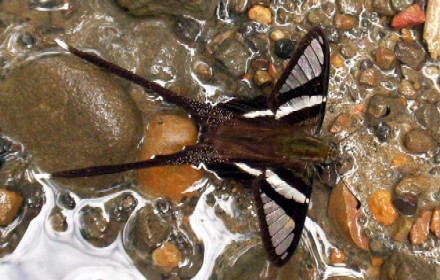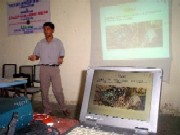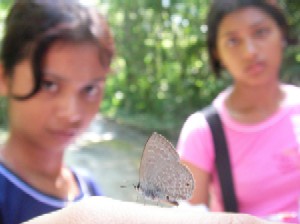Bangalore: Colourful Butterflies Woo Visitors at their Own Park
| by Meenakshi Karanth |
November 26, 2006 It’s colourful. It’s beautiful. And, yes, it’s breath-taking. It’s nothing but a butterfly. From a usual-looking caterpillar to a stunning butterfly - this metamorphosis is by far one of the most beautiful metamorphoses one can find. As colourful as they are, butterflies also occupy an important place in maintaining the ecological balance.
Most of us are acquainted with only a few species of butterflies that we may encounter while taking a stroll in our garden. A reality check will take you by surprise. India is home to around 1,500 species of butterflies among the 17,000 species that are found all around the world. They constitute more than 65% of India’s fauna. What better way to conserve these species than having an exclusive park for them. The garden city of India, Bangalore, is now the first city in the country to have an exclusive Butterfly Park. A unique initiative, this park has been well planned with vast expanse of lush green landscapes and hosts of colourful butterflies.
Inaugurated by union minister of science and technology Kapil Sibal on November 25, the Butterfly Park located at the Bannerghatta Biological Park is amidst naturally landscaped rivulets, wetlands and hillocks, constituting an ideal place for most species of butterflies. Chief minister of Karnataka H D Kumaraswamy was also present at the inauguration which also marks one of the activities as part of the celebration of Suvarna Karanataka in Bangalore. Established through a grant from the department of bio-technology, government of India and government of Karnataka, the park will eventually become an active centre for environmental education, research and conservation of butterflies. Built at a whopping cost of Rs.5 crore, the Butterfly Park situated over a sprawling 7 acres, offering visitors a memorable trip and rich aesthetic appeal. Right from the entrance, visitors are surrounded by some of the most beautiful butterflies. As they walk along the Butterfly Trail, the proximity with butterflies gets even better.
Something unusual at the park is the Butterfly Conservatory, a huge dome-shaped structure with approximately 10,490 square feet of landscaped area meeting all possible habitat requirements including host plants for housing butterflies. It is not just visual appeal at the park. There is also a museum that includes computer animations and other educational information regarding butterflies. The park is aimed at conservation of butterflies in India, raising host plants for butterflies and sensitizing people regarding issues like butterfly conservation. It also supports a number of research and academic work like studying community ecology, DNA finger-printing and molecular phylogeny of economically valuable species of butterflies in peninsular India. A trip to the park will surely enhance your realm of knowledge. An ideal getaway for the family, the park is bound to involve you in various activities like education, entertainment and relaxation. The park will open to the public from November 29. It will remain open from 10 am to 5 pm on all days except Tuesday (holiday). An entry fee of Rs. 20 will be charged for adults and Rs 5 for children and will be free for mentally and physically challenged people. Make sure, while in Bangalore, the Butterfly Park is on your itinerary as it is going to be a worthwhile visit.
|
Story
























